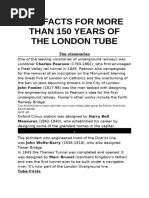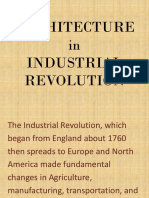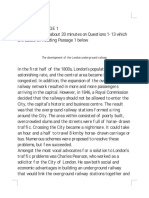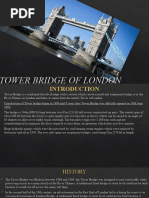River Thames Central London Tower Hill Tooley Street London Clay Shield Peter W. Barlow 2 FT 6 in Narrow Gauge
River Thames Central London Tower Hill Tooley Street London Clay Shield Peter W. Barlow 2 FT 6 in Narrow Gauge
Uploaded by
arem_pransiskoCopyright:
Available Formats
River Thames Central London Tower Hill Tooley Street London Clay Shield Peter W. Barlow 2 FT 6 in Narrow Gauge
River Thames Central London Tower Hill Tooley Street London Clay Shield Peter W. Barlow 2 FT 6 in Narrow Gauge
Uploaded by
arem_pransiskoOriginal Title
Copyright
Available Formats
Share this document
Did you find this document useful?
Is this content inappropriate?
Copyright:
Available Formats
River Thames Central London Tower Hill Tooley Street London Clay Shield Peter W. Barlow 2 FT 6 in Narrow Gauge
River Thames Central London Tower Hill Tooley Street London Clay Shield Peter W. Barlow 2 FT 6 in Narrow Gauge
Uploaded by
arem_pransiskoCopyright:
Available Formats
The Tower Subway is a tunnel beneath the River Thames in central London, between Tower Hill on
the north bank of the river and Vine Lane (off Tooley Street) on the south. In 1869 a 1,340-foot-long
(410 m) circular tunnel was dug through the London clay using a cast iron shield, an idea that had
been patented in 1864 by Peter W. Barlow but never built.[1]
A 2 ft 6 in (762 mm) narrow gauge railway was laid in the tunnel and from August 1870 a cable-
hauled wooden carriage conveyed passengers from one end to the other. This was uneconomic and
the company went bankrupt by the end of the year. The tunnel was converted to pedestrian use and
one million people a year crossed under the river, paying a toll of a ha'penny. The opening of the toll-
free Tower Bridge nearby in 1894 caused a drop in income and the tunnel closed in 1898, after
being sold to the London Hydraulic Power Company. Today the tunnel is used for water mains.
The same shield method of construction was used in 1890 to dig the tunnels of the City and South
London Railway, the first of London's electrified "Tube" railways and the first underground electrified
railway in the world.[2]
You might also like
- CDocument2 pagesCidonotspammeNo ratings yet
- Tower BridgeDocument6 pagesTower BridgeCalvin PratamaNo ratings yet
- 150 Facts for More Than 150 Years of the London TubeDocument14 pages150 Facts for More Than 150 Years of the London TubeSzilvia HegyineNo ratings yet
- London UndergroundDocument11 pagesLondon UndergroundFernando FalcatoNo ratings yet
- Hoa Re600Document3 pagesHoa Re600migo cruzNo ratings yet
- The Development of The London Underground RailwayDocument2 pagesThe Development of The London Underground RailwayHồng QuânNo ratings yet
- BTVN buổi 7Document3 pagesBTVN buổi 7Thinh NgôNo ratings yet
- 1 - Đề thi IELTS ReadingDocument3 pages1 - Đề thi IELTS Readingduyduy09052021No ratings yet
- Referat Engleza Tower BridgeDocument2 pagesReferat Engleza Tower BridgeTatianaNo ratings yet
- Role of Rail Transport in Tourism IndustryDocument45 pagesRole of Rail Transport in Tourism IndustryGLOBAL INFO-TECH KUMBAKONAMNo ratings yet
- Tower BridgeDocument3 pagesTower BridgeAlina GhitaNo ratings yet
- Industrial RevolutionDocument28 pagesIndustrial RevolutionMa. Lourdes Angerica P. Aquino100% (1)
- Tower BridgeDocument3 pagesTower BridgeMilena PopovaNo ratings yet
- White CityDocument7 pagesWhite CityMuhammadMazidNo ratings yet
- British Narrow-Gauge Railways - WikipediaDocument29 pagesBritish Narrow-Gauge Railways - WikipediaOlugbenga A AdetunjiNo ratings yet
- C17T1 - Reading 1Document3 pagesC17T1 - Reading 1Zahra Hasana SalsabilaNo ratings yet
- (English) How The World's First Metro System Was Built - Christian Wolmar (DownSub - Com)Document4 pages(English) How The World's First Metro System Was Built - Christian Wolmar (DownSub - Com)gfffNo ratings yet
- Railway TimelineDocument9 pagesRailway TimelineJohanFaqar ZainNo ratings yet
- TramDocument33 pagesTramellsworth.jack.perryNo ratings yet
- Reading PracticeDocument19 pagesReading Practicenafisirtiza65No ratings yet
- No 4 Major SubwaysDocument2 pagesNo 4 Major SubwaysAndiKhaerin0% (1)
- Tunnels ScriptDocument1 pageTunnels ScriptIvanStanicNo ratings yet
- Info Sheet 10 Lts RailwayDocument2 pagesInfo Sheet 10 Lts Railwaylifelongmai comNo ratings yet
- London Bridge: From Wikipedia, The Free Encyclopedia Jump To:, For Other Uses, See .Document10 pagesLondon Bridge: From Wikipedia, The Free Encyclopedia Jump To:, For Other Uses, See .Maulana Mansur SyahdanNo ratings yet
- History of Iron and Steel BridgesDocument2 pagesHistory of Iron and Steel BridgesKAii Magno Guia0% (1)
- TunnelsDocument4 pagesTunnelsPaul ButucNo ratings yet
- A Brief History of London UndergroundDocument3 pagesA Brief History of London Undergroundsukhwant1666No ratings yet
- TFNGDocument6 pagesTFNGkirana anjaniNo ratings yet
- Reading Passage 1 (1)Document3 pagesReading Passage 1 (1)Long VũNo ratings yet
- By, Akshata A MulgundDocument153 pagesBy, Akshata A MulgundSaurav AdhikariNo ratings yet
- Excavation Methods in TunnelingDocument17 pagesExcavation Methods in Tunnelingcbelhann1No ratings yet
- READINGDocument12 pagesREADINGhuyengiangnguyend9No ratings yet
- The Regent's Canal Second Edition: An urban towpath route from Little Venice to the Olympic ParkFrom EverandThe Regent's Canal Second Edition: An urban towpath route from Little Venice to the Olympic ParkNo ratings yet
- Tower Bridge of LondonDocument15 pagesTower Bridge of Londoncatalin barascuNo ratings yet
- Reading Cam17 Part1Document3 pagesReading Cam17 Part1khanh270503aNo ratings yet
- 49.7._railway_chapterDocument51 pages49.7._railway_chapterjepoliverNo ratings yet
- History of TrainsDocument10 pagesHistory of TrainsKhurram ShahzadNo ratings yet
- ITTS Midterm ReviewerDocument9 pagesITTS Midterm ReviewerNesha SierraNo ratings yet
- Nottingham Canal TimelineDocument1 pageNottingham Canal Timelineapi-270946959No ratings yet
- Old TransportationDocument17 pagesOld Transportationanon_370263793No ratings yet
- Archway Bridge Heritage ReportDocument39 pagesArchway Bridge Heritage Reportsarah AL-OBAIDYNo ratings yet
- EnglezaDocument8 pagesEnglezaDanu GolbanNo ratings yet
- London's Historic Railway Terminal Stations: An Illustrated HistoryFrom EverandLondon's Historic Railway Terminal Stations: An Illustrated HistoryNo ratings yet
- T-F-NG Practice for Foundation ReadingDocument3 pagesT-F-NG Practice for Foundation ReadingNguyễn Lâm Tuệ MinhNo ratings yet
- Tower Bridge: Tower Bridge Is A Combined Bascule and Suspension Bridge in London, BuiltDocument1 pageTower Bridge: Tower Bridge Is A Combined Bascule and Suspension Bridge in London, BuiltBikeritaNo ratings yet
- Tower Bridge of LondonDocument19 pagesTower Bridge of Londonsaurabh sahuNo ratings yet
- BridgesDocument4 pagesBridgesdhruv kapoorNo ratings yet
- Construction 3Document1 pageConstruction 3arem_pransiskoNo ratings yet
- Telecommunication Cables Tower of LondonDocument1 pageTelecommunication Cables Tower of Londonarem_pransiskoNo ratings yet
- Stationary Steam Engines D: Page NeededDocument1 pageStationary Steam Engines D: Page Neededarem_pransiskoNo ratings yet
- Construction: Cast Iron LimeDocument1 pageConstruction: Cast Iron Limearem_pransiskoNo ratings yet
- TABBINGSDocument1 pageTABBINGSarem_pransiskoNo ratings yet
- Research Paper On Contemporary Police ProblemsDocument2 pagesResearch Paper On Contemporary Police Problemsarem_pransiskoNo ratings yet
- Lebios, Earthlyn Cardino: I Hereby Certify That The Above Information Is True and Correct To The Best of My KnowledgeDocument2 pagesLebios, Earthlyn Cardino: I Hereby Certify That The Above Information Is True and Correct To The Best of My Knowledgearem_pransiskoNo ratings yet


































































